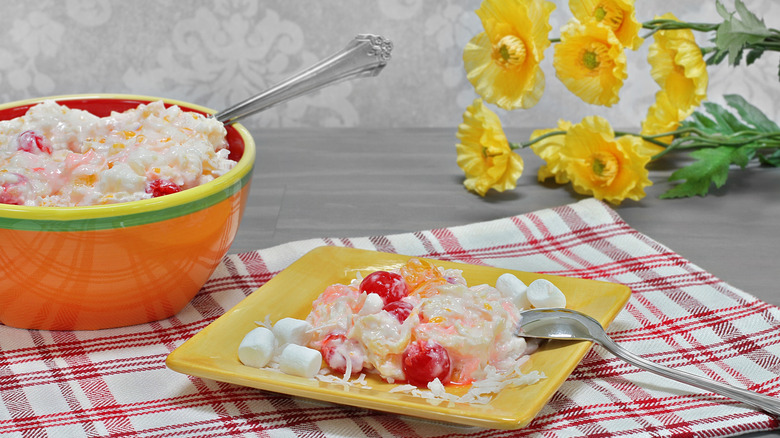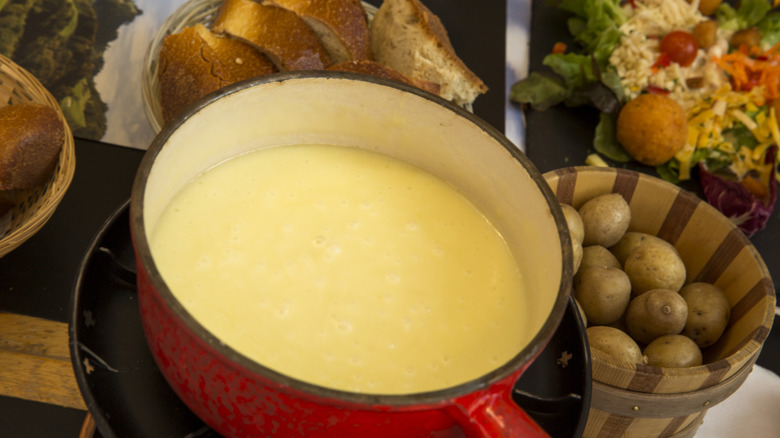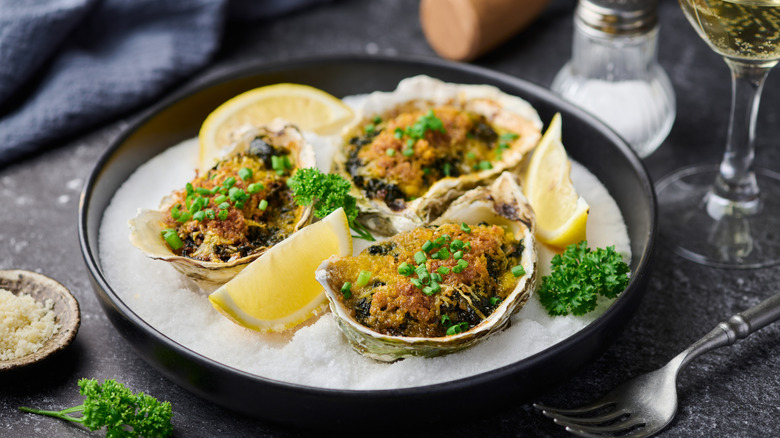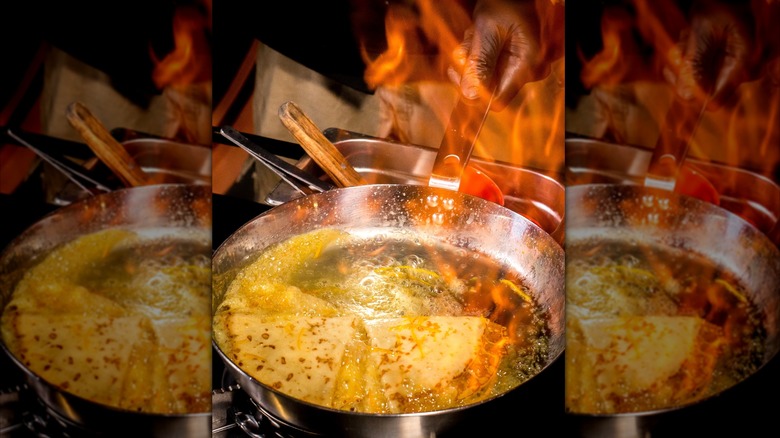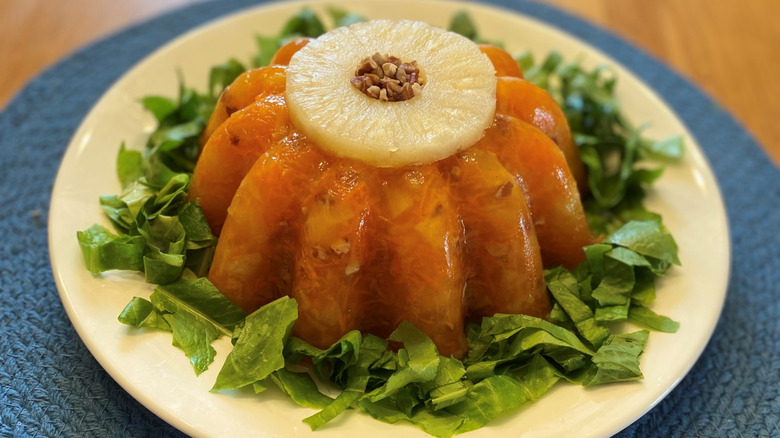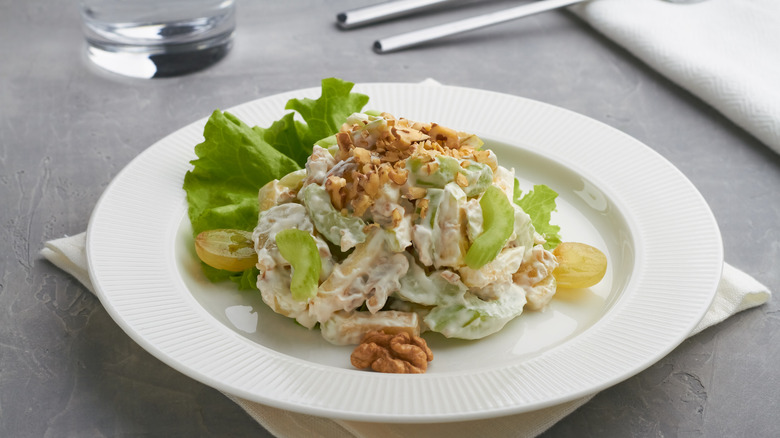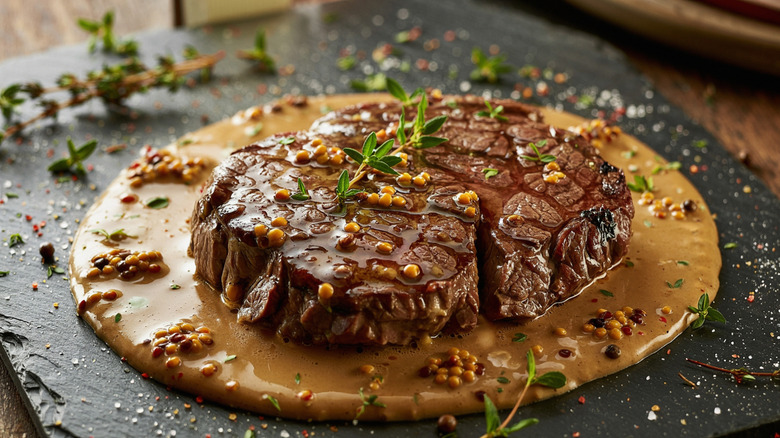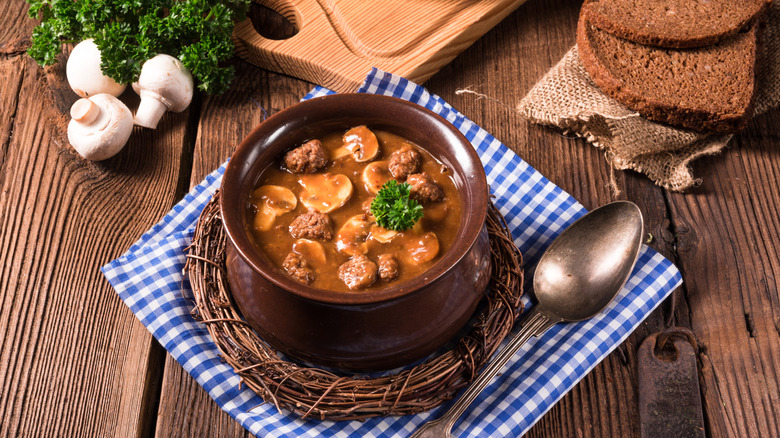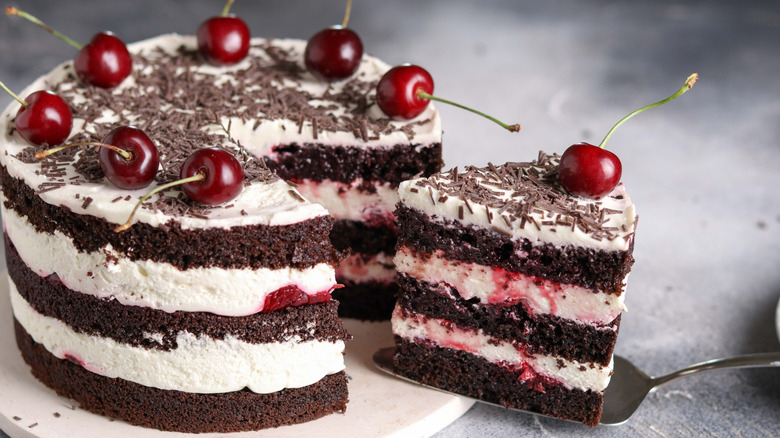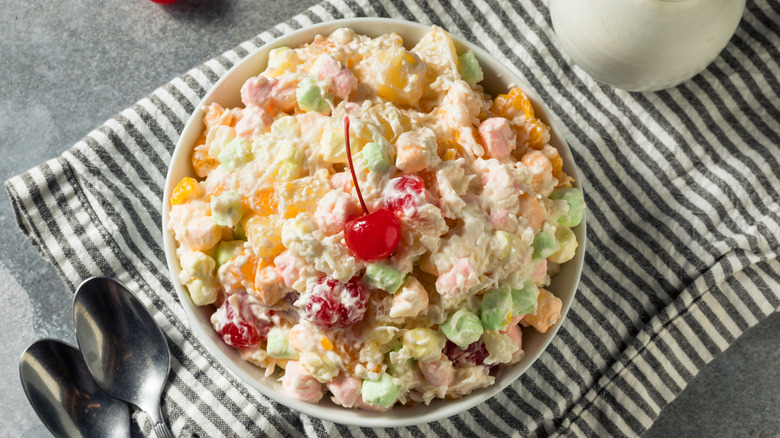11 Old-School Dishes That Were Once Considered Fancy (But Not Anymore)
Food fashions come and go, and what once seemed like the height of sophistication can later feel hopelessly out of date. There are some old-school dishes that were once considered fancy — but aren't anymore. Every generation has its dishes you might have proudly served at a dinner party or ordered to impress on a night out. But as tastes evolve and trends shift, those same plates can end up being seen as quaint, retro, or kitschy.
It's not that these dishes suddenly became bad. Many are still delicious when made well — but context matters. Fondue was once seen as sophisticatedly European, while today it feels like a 1970s nostalgia trip. Similarly, elaborate dishes that once wowed diners now feel a little too heavy or fussy for modern tastes.
Looking back at these once-fancy foods is a reminder of how our relationship with dining isn't just about flavor. Trends, popular media, and the cultural zeitgeist all play their part in making certain dishes aspirational — until they aren't. What was once luxurious may now be old-school or retro, mostly enjoyed ironically or as a throwback.
Here are some classic examples of old-school dishes that were once elegant and luxurious, only to fade from fashion over time. They might not carry the same cultural cachet today, but they still tell an engaging story about how food trends evolve. And even if they're not fancy, many of them still taste great.
1. Fondue
Few dishes capture a specific cultural moment as clearly as fondue. It originated as a simple Swiss dish in the 17th century. It consists of melted cheese, served in a communal pot, with long forks for dipping bread cubes, meats, and veggies. In Switzerland, it was originally a way for poor rural families to stretch limited food stores over the winter months. But in the mid-20th century, fondue took on a very different identity.
In the 1960s and '70s, it became a global sensation, marketed as the ultimate in continental sophistication. Companies sold fondue sets promising an instant upgrade to any dinner party. You're probably picturing a brightly colored enamel one with bold floral patterns right now. Hosting friends for fondue signalled that you were modern, worldly, and a little glamorous.
Today, the sight of a fondue pot is more likely to inspire nostalgia than admiration. Once considered chic, it's now associated with retro dinner parties, wood-paneled basements, and avocado-green kitchenware. To modern diners, the idea of eating out of a shared pot of molten cheese feels more kitsch than classy.
Still, fondue hasn't disappeared entirely. It survives in ski lodges, specialty restaurants, and occasional themed nights. While it may no longer be a marker of sophistication, it still holds up. Who doesn't want the excuse to dip things in a pot of melty cheese, quite honestly?
2. Oysters Rockefeller
When Oysters Rockefeller debuted in New Orleans in 1899, the dish was a sensation. Created at Antoine's Restaurant, it consisted of oysters baked on the half shell with a rich topping of spinach, breadcrumbs, and cheese. The recipe still remains secret to this day. It was so rich and decadent that it was named after John D. Rockefeller, the wealthiest man of the era. At the time, it symbolized extravagance and refinement, turning a humble shellfish into something grand.
For much of the 20th century, ordering Oysters Rockefeller would have showed off your sophistication. It graced the menus of fine dining establishments across the country and became a staple of glamorous cocktail parties. Anyone who was anyone would order this dish or serve it up at soirees to show good taste.
But food fashions changed. As diners leaned toward lighter, fresher flavors, the heavy richness of Oysters Rockefeller began to feel dated. By the late 20th century, it had lost much of its luster, seen as more of a throwback than a showstopper. Today, you're more likely to encounter it on a "classics" section of a menu than as a centerpiece dish. That doesn't mean it's without appeal. It offers a glimpse into a time when richness and excess defined fine dining. It may not dazzle modern food lovers the way it once did, but it's an interesting look at an iconic dish from the past.
3. Crêpes Suzette
Few desserts have the same level of tableside drama as crêpes Suzette. This French creation is made by folding delicate crêpes into a buttery sauce of sugar, orange juice, zest, and liqueur, usually Grand Marnier or Cointreau. The real flourish comes with the flambé, when the liqueur is ignited, creating a flame that's not just for show — it also caramelizes the sugar and cooks off some of the alcohol for a more subtle flavor. Crêpes Suzette reportedly dates back to the late 19th century, with stories tying its invention to a chance mistake while a chef was preparing dessert for the Prince of Wales, later King Edward VII.
Throughout the mid-20th century, the dish became a staple of fine dining restaurants. Guests were wowed when waiters set light to their dessert right at the table. But as tastes shifted, crêpes Suzette began to feel like a relic of another era. The flambé trend itself waned, and many modern diners now associate it with retro dining rooms rather than cutting-edge cuisine.
Today, this dish still holds charm, but not the same aura of sophistication it once commanded. Once a pinnacle of dessert theater, it's now a retro classic. It's certainly not seen as something fancy to impress your friends with at your next dinner party anymore. Which is just as well, for the safety of your eyebrows.
4. Chicken à la king
Chicken à la king may sound like a regal dish, but it doesn't have any royal connections. It's a rich, creamy stew made of chicken, mushrooms, and bell peppers, often finished with a splash of sherry or Madeira. The mixture could be served over puff pastry, noodles, or rice. It might not sound fancy today, but there was a time when it was popular.
The exact origin is debated, with claims tracing it to the 1880s or 1890s. What's clear is that by the early 20th century, chicken à la king was a fashionable dish, appearing on hotel menus and in cookbooks as a sophisticated way to use poultry. Its creamy, wine-infused sauce was luxurious at a time when a lot of home-cooked food was quite simple.
By the mid-20th century, however, the dish became more of an everyday staple, often made with shortcuts like canned mushrooms or condensed soup. What was once elegant dinner-party fare slipped into the realm of school cafeteria food and retro cookbooks. By the 1980s, it was all but written off as a relic from the past. Partly, this may have been because lighter dishes were becoming fashionable, and fatty, creamy foods were less popular. But, people also started to have access to more elevated creamy dishes.
Today, some people see chicken à la king as a nostalgic dish, but it's rarely considered fancy. It's now firmly planted in the kitsch category of mid-century American dining. Still, if you want to make your own, try our easy chicken à la king recipe.
5. Jellied salads
If you're thinking of the brightly colored molded dishes of the '50s and '60s, you only know half of the rise and fall of jellied salads. Their origins actually go back centuries. In medieval Europe, elaborate aspics made with savory gelatin were considered a mark of wealth, as producing clear gelatin required significant time and resources. These dishes showcased the host's status as much as their — or their cook's — culinary skill. These types of dishes were popular with the elite right through to the mid-19th century.
Fast forward to the 20th century, when Jell-O and similar products made gelatin inexpensive and accessible. By the mid-century, molded salads became a centerpiece at dinner parties across America. Recipes ranged from sweet versions featuring fruit and marshmallows to more daring savory combinations with vegetables, seafood, or even canned meats. Their vibrant colors and elaborate shapes were meant to impress guests. They were meant to be fancy.
But jellied salads aren't as popular as they once were. By the 1970s and 1980s, jellied salads were seen as fussy and unappetizing. Fresher, less processed foods grew in popularity and these were relegated to the past. Today, they're viewed as highly retro — and slightly baffling. You wouldn't see anyone listing them as a fancy food or serving them at a high-end restaurant. In fact, many people see them as barely edible.
6. Waldorf salad
When it was invented, Waldorf salad was the height of turn-of-the-century glamor. Created in the 1890s at New York's prestigious Waldorf-Astoria Hotel, it began as a simple mix of apples, celery, and mayonnaise. Over time, walnuts and grapes were added, rounding out the dish into the version most people know today. At its peak, Waldorf salad was seen as fancy — a light, refreshing starter with a distinctly cosmopolitan air. It was the sort of thing you might expect to see at a high society lunch or a dinner party where elegance mattered more than heartiness.
By the mid-20th century, the salad had spread far beyond New York's elite dining rooms and into cookbooks and homes across America. It became one of those dishes that was suitable for special occasions but easy enough to make at home, which ironically helped bring about its decline in status. Once something becomes ordinary, it loses its sense of luxury. Today, Waldorf salad is more likely to be thought of as dated banquet fare than a cutting-edge dish. Perhaps it was around the time that folks started putting marshmallows in it that it stopped being so fancy.
It might not be seen as refined today, but people are still making this dish. We even have an old-fashioned Waldorf salad recipe you can follow if you're looking to make your own. Just don't assume it's going to impress anyone used to haute cuisine.
7. Steak Diane
Steak Diane was once a guaranteed showstopper bound to impress. Today it's one of those vintage steak dishes you rarely see on restaurant menus. It has well and truly gone out of fashion. For those who don't know, it's a pan-fried steak served with a rich sauce made from ingredients such as butter, shallots, and cognac. What made it special, though, was the tableside preparation. Waiters would roll up a cart and flambé the dish right next to your seat.
The dish rose to prominence in mid-20th century America, though its roots are debated. Some suggest it was named for Diana, the Roman goddess of the hunt, while others say it was named after the daughter of the chef who created it at Drake Hotel in Manhattan. Either way, Steak Diane was a hugely popular dish in the '50s and '60s. For a time, it was almost impossible to imagine a fancy night out without seeing it on the menu.
Over the decades, however, tableside flambé service fell out of demand. Diners began favoring simpler, ingredient-driven dishes over the spectacle of old-school fine dining. Steak Diane became a retro relic. It's not that it's a bad dish, it's just that peoples' preferences changed over time. Diners might still enjoy steak, but they don't necessarily want it to be set alight at their table.
8. Mock turtle soup
Mock turtle soup was once seen as a fancy starter, but later became the kind of thing you'd find in a can. And now it's something you barely talk about at all. But if you have heard of mock turtle soup, you might not realize its history. In the 18th and 19th centuries, turtle soup was considered a delicacy in Britain and America, especially made with green sea turtles. While it wasn't the kind of thing the aristocracy ate, it was seen as a high-end meal for the middle classes.
But as people started to hunt turtles extensively, their numbers declined and their meat became costly and difficult to source, so cooks created a substitute. Using calf's head, they developed "mock turtle soup," which aimed to replicate the rich, gelatinous texture of the real thing. The dish gained traction and carried over to the United States, where it was popular in fancy restaurants. At the time, it was still seen as sophisticated and often sold for more than other soups.
By the mid-20th century, though, it wasn't seen as such a luxury dish. It was available canned, which wasn't a sign of sophistication. Plus, tastes shifted and it was seen as odd and outdated. Now, you'll rarely find mock turtle soup outside of specialty cookbooks or historical menus.
9. Shrimp cocktail
At its height of popularity in the 1960s and '70s, shrimp cocktail was a restaurant staple, often arriving at the table in a stemmed glass. Or people would serve it at dinner parties in half an avocado (that nobody ate because it was rock hard). Shrimp was still considered a luxury ingredient, and this kind of presentation was seen as sophisticated. The sharp hit of horseradish and ketchup-based sauce was a hit.
But over time, shrimp cocktail lost its sheen. The dish became overdone. Everyone was making it, so it no longer carried the same air of extravagance. Shrimp cocktail didn't evolve with the times and it started to feel more like a throwback than something modern and exciting. These days, you might find it at a wedding buffet or it might be served as a retro throwback, but it's certainly not fancy.
Still, it holds nostalgic appeal. The combination of sweet shrimp and tangy sauce works for a reason, and chefs occasionally bring it back in more updated forms. While it may no longer be considered high-end dining, it's still a dish that lots of people enjoy. It hasn't been relegated entirely to the past.
10. Black Forest cake
There's no denying Black Forest cake looks impressive. With its layers of chocolate sponge, whipped cream, and cherries, you can see why it used to be an iconic showpiece dessert. Originating in Germany, where it's known as Schwarzwälder Kirschtorte, the cake traditionally includes a splash of kirsch (cherry brandy) to deepen its flavor. Its origins are unclear, but by the mid-20th century, it had become a centerpiece for celebrations, especially in Europe and North America.
However, like many elaborate desserts of its era, Black Forest cake eventually lots its appeal. It was particularly popular in the 1970s when it was seen as a fancy way to round off a dinner party. And while it was still around in the '80s and '90s, it was beginning to feel heavy and old-fashioned. Supermarket versions, often made with artificial flavors and canned cherries, didn't help its reputation either, turning it into something that felt dated.
That said, when made properly, Black Forest cake still delivers. The balance of bitter chocolate, tart cherries, and airy cream can be delicious. It's not overly sweet, as it uses whipped cream instead of frosting, so it feels a bit grown-up. While it's no longer the pinnacle of sophistication it once was, this cake still deserves some attention.
11. Ambrosia salad
Ambrosia salad perfectly captures mid-20th-century American dining trends. A mix of canned fruit, mini marshmallows, shredded coconut, and whipped cream (or sometimes a whipped topping), you'd find it at basically any holiday gathering or potluck. The name, "ambrosia," suggests a food fit for the gods, and it was once considered a luxury, although it's definitely not anymore.
The dish first appeared in the mid-1800s, when coconut and citrus were expensive delicacies. At this point, the recipe was simpler — just orange, sugar, and coconut — but these ingredients weren't readily available, so the dish was a status symbol. It eventually trickled down as the ingredients became more affordable and was popular from the 1940s to '80s, but reached its cultural peak in the '50s and '60s. At that time, convenience foods were celebrated, and ambrosia fit the bill perfectly. It required no baking, no special equipment, and was a welcome addition to the menu.
Today, though, ambrosia salad is often seen as kitsch. The reliance on canned fruit and marshmallows feels outdated in an era that emphasizes fresh, seasonal ingredients. While some families still treasure it as a holiday tradition, it's more about nostalgia. If you rocked up to a 21st century potluck with a dish of ambrosia salad in your hands, you'd probably get a strange look and return home with a full bowl at the end of the night.
